According to statistics, almost half of all appeals to dermatologists, one way or another, are associated with fungal disease. You can take the infection while visiting the pool, sauna, after visiting the beach or visiting your slippers.
Learn everything about how to recognize nail fungus on the feet without binding and the use of other diagnostic methods - symptoms of manifestation of early and chronic stage onychomycosis.
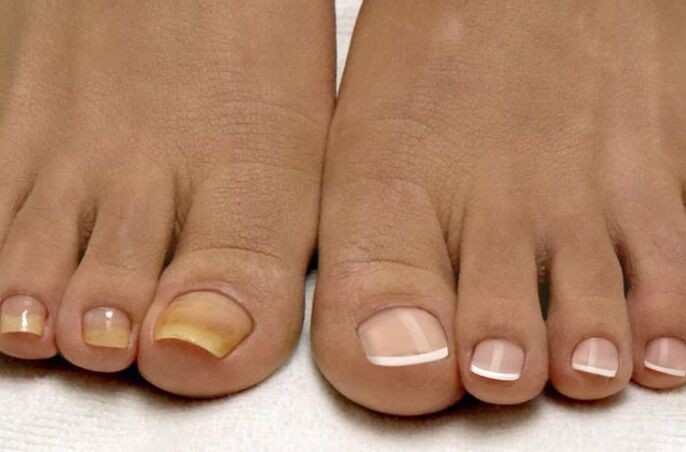
Many do not suspect that foot sweat, accompanied by an unpleasant odor, which more than half of our planet suffered, is one of the main symptoms of nail fungus. The disease is at risk of having a little pain at least ignoring personal hygiene.
Nail fungus is waiting anywhere, especially in public use. And the worst thing is that nail fungus is a very dangerous disease: the treatment is long, and not always successful, as mycosis tends to relapse.
To recognize the disease over time and start the treatment, you should know all the signs of fungus on the feet.
How does this disease spread?
This infection is caused by parasitic fungus. The ideal environment for breeding and their development increases moisture in combination with a warm atmosphere. It is generally accepted that the main places where the risk of infection with high nail fungus is bath, sauna, water garden, swimming pool, manicure salon, etc.
However, statistics are fully denied this statement: nail fungus can be taken at home through normal matters (towels, shoes, clothing, carpets, shower or bathroom), if one of the family members already has this problem, or on the side, for example, through slippers, suggested by the owner (and he may not suspect the presence of the disease).
But what factors affect the development of fungal disease? Moments -such basic comments are observed, leading to infection with onychomycosis:
- decline in immunity;
- nail plate injury;
- violations of blood circulation in the lower leg, which can occur when wearing tight shoes;
- foot pathology of anatomical nature;
- obesity;
- Diabetes mellitus;
- Increased sweating.
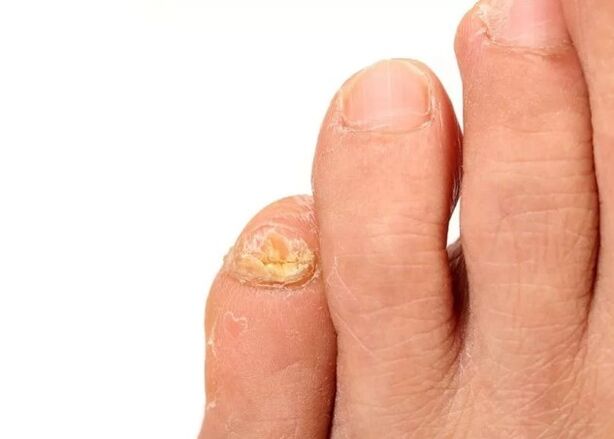
For at least partially protect yourself, you should use your items exclusively, carefully treat bathing and bathing with antiseptic, use personal towels, regularly cleaning and cleaning carpets, eradicating shoes. And in order not to miss a good time for the treatment of mikosis (after all, everyone knows that the most effective therapy in the early stages of the disease is the development of the disease), you need to know the first signs of nail fungus.
After recognizing the first signs of nail fungus, you should immediately contact a specialist who will set the optimal treatment regimen.
What are the different types of real onychomycosis?
3 types of onychomycosis are determined, each shown in its own sign.
You can determine the presence of fungus on your own nails, but only experts can establish the right diagnosis. To do this, you need to visit the clinic, take it to analyze the nail or skin binding around it. In addition, dermatologists set microscopic or cultural studies.
Signs of fungus by disease pathogens
The success of nail fungus treatment depends on how the right pathogen is diagnosed. This is explained by the fact that the disease does not cause one type of fungus, but some, and each is sensitive to certain drugs. That is, if one type of fungus is resistant to one drug, then another pathogen dies from this product.
More often, nail fungus causes:
- Yeast;
- dermatophytes;
- mold.
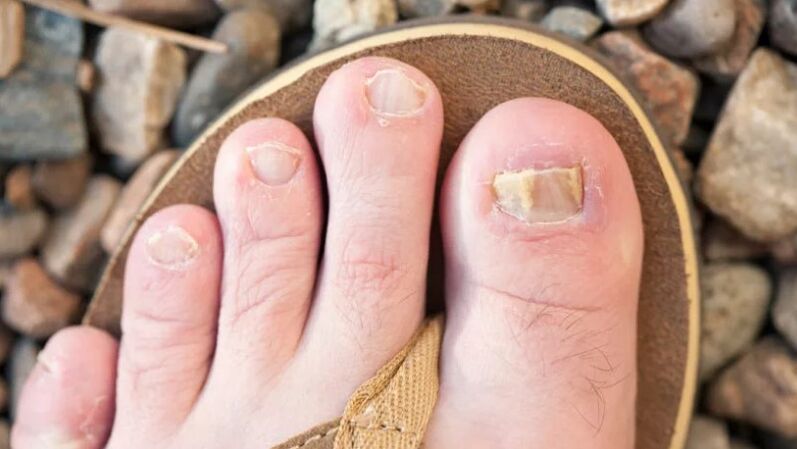
If the cause of the nail fungus becomes yeast, then it is almost impossible to identify the disease immediately. Signs of fungus on the toenails in this case are the following (they appear after a long period of time): peeling nail plates and itching -school light skin near nails (itching may not be present). Failure infection with yeast occurs in 4-4. 5% of cases.
Dermatophytes affect a person's nails more often than previous pathogens - this is 94. 5% of all cases of nail infection with fungus. Dermatophytes are three types, each of which is shown in different ways:
The last type of fungus is mold. The pathogen is a mold. The disease is only available in 1% of cases. One fungus of this species develops more frequently in people with HIV.
Other symptoms of fungal nail infection
Often at the beginning of the disease, the signs of fungal nail damage are not present. However, to be careful, you can see some changes in the nail structure and its appearance.
As mentioned earlier, longitudinal or round white spots can appear on the nail plate, nails can be waves -as, while its smoothness and excellence disappear.
Growing, the disease destroys the nail plate: first changes its shade, then the surface of the nail becomes scaly, it thickens or thickens, relieves, breaks. The color of the nails depends on the type of fungus that is the agent of infection.
In addition to the main signs of onychomycosis, there are others:
- fragility of the edges of the nail plate or the entire surface;
- nail shape, scaly structure;
- Nail blacation;
- Cut nails under the skin;
- dysbiosis, drowsiness, general weakness;
- plate detachment from the nail bed, leading to the formation of plaque under the white or yellow nail with an unpleasant odor;
- itching, cracks, skin burns around the affected nails;
- Dysbiosis, drowsiness, general weakness.

Any distortion in the appearance of nails in the foot should be awake, as this may indicate the development of nail fungus. The first action in this case is a journey to a dermatologist who will confirm or deny your fears. If this is not done immediately, the disease will develop.
At first glance, there is nothing wrong with the disease. However, in addition to only aesthetic problems and discomfort, fungus can cause serious complications, so the purulent infection of the affected area as well as the development of gangrene.
Therefore, do not tighten with treatment, take steps at once, as the disease is detected.
Like what nail fungus
Every third person on Earth sees problems such as stratification and nail polish, eliminating plates - this is onychomycosis. The disease affects various age groups. Nail fungus on the feet (the picture is presented below), quickly spreading and adjusting to the new situation. We will consider in more detail the main factors of the incident, type and method of treating fungus.
What is a nail fungus?
Onychomycosis is a pathology that destroys the nail plate. Fungus eating keratin - the base of the nail construction. The infection falls into the space between the cells and begins its division. In advanced stages, pathology can affect the skin, intercal zone, heel.
Do not start the fungus and treat it immediately
Causes of nail fungus
Infected with onychomycosis is relatively simple. These infections can hide on the beach, in the public soul, swimming pool. The high probability of catching fungus from relatives or infected contacts (using a joint life).
There are several major prerequisites that can trigger the entry of the virus into the human body:
- Weak immune system - decreased protection of infectious diseases or inflammation;
- Vascular pathology (vein blockage) violation of internal organs (diabetes), leading to problems with blood circulation in the lower part;
- Small damage to the skin of the feet (lecet, microcracks, corn, corn) arising from wearing tight shoes;
- ignoring diaper rash and intensive sweat from lower feet;
- Violation of Steps -Heartbeat -Trying other people's shoes, visiting public places without slippers, and neglect of foot hygiene.
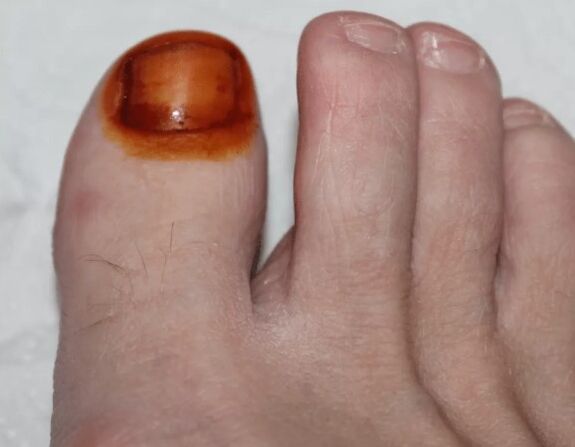
Type of nail fungus
Onychomycosis can trigger several types of fungus. For example, dermatophytes appear in the form of nails. There is a yellow spots forming along the edges or in the middle of the plate. In addition, longitudinal strips along the affected area can be observed.
In the final stage of nail fungus, surgical intervention may be required
Yeast fungus causes a nail plate deformation. He was very sophisticated and began to move from his place, to gray. The metabolism in the injured cells worsened, the commotion appeared on the nail roller. In addition, inflammation, edema, redness appear in the adjacent epidermis, loss of nail skin is observed.
Mold bacteria can injure the nail plate if there is a disease that causes nail nutrition. In this case, there is also plate approval, color change (from yellow light and green to brown and even black).
To find out the causes and pathogens of negative changes in the skin and nails, you must contact a specialist. Determination of free diseases and treatment without consulting a doctor who can be met with consequences.
A folk method
Against the early stages of development, non -traditional agents can be used. Here are the most effective:
- Every day in the morning and before bedtime, until the symptoms are completely lost, apply iodine on mushroom -plated nail plates;
- Mix 3 tablespoons of water with one teaspoon of glycerol, vinegar and iodine. Nail composition for 10 days;
- Mix 9% vinegar with water in a rate of 1 to 8. Dear foot in liquid produced for 20 minutes. The procedure is repeated daily. There should be 7-10 of them;
- Put the raw eggs in the container and pour the vinegar 9%. After the complete dissolution of the shell, remove the remaining film, mix the vinegar with the egg. The solution is treated with fungal nails twice daily for 3 weeks;
- Dissolve 4 tablespoons of hydrogen peroxide in 2 liters of water. Inside the container, lower your feet, keep for 20 minutes. The course of treatment is 10 days;
- To moisturize the cotton sweep in the peroxide, attach it to the nail, which is affected by fungal infections. Before the procedure, the feet should be steamed in the bath with soda. Above, the compress is wrapped with cellophane. Store for an hour. Therapy lasts for 2 weeks;
- Moisturize the cotton pad into 20% alcohol tincture propolis, attach it to the infected nail. Make sure the compress is completely dry. This procedure is performed twice daily. The treatment persists until the symptoms of the disease are completely lost;
- Clean the garlic cloves, cut to the floor. To get wet into salt and destroy their nails. Procedures to do twice daily until the features of the fungus are completely lost;
- Add 2 teaspoons of ammonia to a glass of water. In the solution, moisturize the cotton pad, apply it to the nails affected by the fungus, leaving overnight. The course of therapy is 7 days;
- Blend the onion thoroughly until the gruel is formed. Apply the product to the infected nail plate for half an hour. Treatment is carried out daily until complete recovery;
- The mint, wise and chamomile in the same proportion. Pour the medicine plant into the feet and place it at night. Every day, grass must be converted to fresh ones. This tool is used in addition to other methods;
- Take the same quantity of tea tree oil and celandine. To absorb the cotton pad, place on the infected nail for 45 minutes. The course of treatment is 20 days. This device is not allowed to use during pregnancy;
- In 500 ml of water, drink 6 teaspoons of tea. In boiling, moisturize cotton wool, place on a nail plate with onychomycosis. Continue treatment until the symptoms are completely lost.
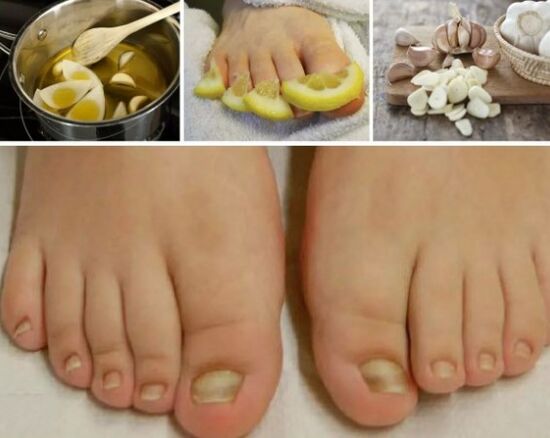
All folk medicine can be used only after consulting a dermatologist. Many of them can trigger allergic reactions. It is easier to cure onychomycosis by combining non -traditional medicines with medicines.
In the early stages, the fungus on the feet looks like a almost invisible groove or a white spots. Usually one learns about the presence of fungal infections only during a visit to a dermatologist. This is due to the fact that it is almost impossible to recognize the disease during this period. If you start therapy in time, then the disease heals quickly.
















